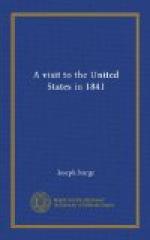on board with Pedro Montez. The Amistad was a
coaster, bound to Principe, in Cuba, distant some
two or three hundred miles. The Africans
were kept in chains and fetters, and were supplied
with but a small quantity of food or water. A
single banana, they say, was served out as food
for a day or two, and only a small cup of water
for each daily. When any of them took a little
water from the cask, they were severely flogged.
The Spaniards took Antonio, the cabin-boy and
slave to Captain Ferrer, and stamped him on the
shoulder with a hot iron; then put powder, palm
oil, &c. upon the wound, so that they ’could
know him for their slave.’ The cook,
a colored Spaniard, told them that on their arrival
at Principe, in three days, they would have their
throats cut, be chopped in pieces, and salted down
for meat for the Spaniards. He pointed to some
barrels of beef on the deck, then to an empty
barrel, and by significant gestures,—as
the Mendians say, by ’talking with his fingers,’—he
made them understand that they were to be slain, &c.
At four o’clock that day, when they were called
on deck to eat, Cinque found a nail, which he
secreted under his arm. In the night they
held a counsel as to what was best to be done.
‘We feel bad,’ said Kin-na, ’and
we ask Cinque what we had best do. Cinque
say, “Me think, and by and by I tell you."’
He then said, ’If we do nothing, we be killed.
We may as well die in trying to be free as to
be killed and eaten.’ Cinque afterwards
told them what he would do. With the aid of
the nail and the assistance of Grabeau, he freed
himself from the irons on his wrists and ancles,
and from the chain on his neck. He then, with
his own hands, wrested the irons from the limbs
and necks of his countrymen. It is not in
my power to give an adequate description of Cinque
when he showed how he did this and led his comrades
to the conflict and achieved their freedom. In
my younger years I saw Kemble and Siddons, and
the representation of Othello, at Covent Garden,
but no acting that I ever witnessed came near
that to which I allude. When delivered from their
irons, the Mendians, with the exception of the children,
who were asleep, about four or five o’clock
in the morning, armed with cane-knives, some boxes
of which they found in the hold, leaped upon the
deck. Cinque killed the cook. The captain
fought desperately. He inflicted wounds on
two of the Africans, who soon after died, and
cut severely one or two of those who now survive.
Two sailors leaped over the side of the vessel.
The Mendians say ’they could not catch land—they
must have swum to the bottom of the sea,’
but Ruiz and Montez supposed they reached the
island in a boat. Cinque now took command of the
vessel; placed Si-si at the helm; gave his people
plenty to eat and drink. Ruiz and Montez
had fled to the hold. They were dragged out,
and Cinque ordered them to be put in irons. They
cried and begged not to be put in chains, but Cinque
replied, ’You say fetters good for negro—if




